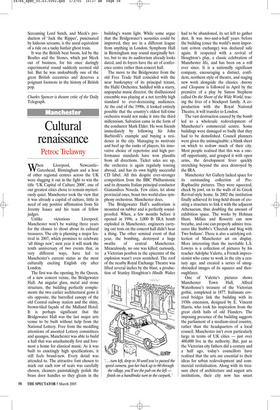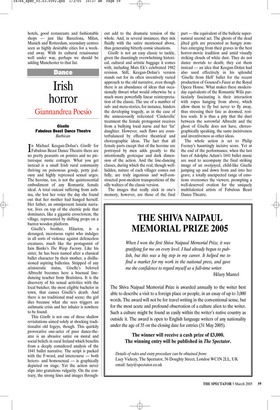Cultural renaissance
Petroc Trelawny
When Liverpool, Newcastle– Gateshead, Birmingham and a host of other regional centres across the UK were slugging it out in the fight to win the title ‘UK Capital of Culture 2008’, one of our greatest cities chose to remain mysteriously quiet. Manchester took the view that it was already a capital of culture, little in need of any positive affirmation from Sir Jeremy Isaacs and his team of fellow judges.
Unlike victorious Liverpool, Manchester won’t be waiting three years for the chance to shout about its cultural treasures. The city is planning a major festival in 2007, which promises to celebrate ‘all things new’; next year it will mark the tenth anniversary of two events that, in very different ways, have led to Manchester’s current status as the most culturally exciting English city after London.
The first was the opening, by the Queen, of a new concert venue, the Bridgewater Hall. An angular glass, metal and stone structure, the building perfectly complements the two earlier architectural gems it sits opposite, the barrelled canopy of the old Central railway station and the shiny, brown-tiled façade of the Midland Hotel. It is perhaps significant that the Bridgewater Hall was the last major arts venue to be built without help from the National Lottery. Free from the meddling attentions of assorted Lottery committees and quangos, Manchester was able to build a hall that was unashamedly first and foremost a home for classical music. As it was built to exactingly high specifications, it still feels brand-new. Every detail was attended to. The attractive font chosen to mark out each row of seats was carefully chosen, cleaners painstakingly polish the brass door handles so they gleam in the building’s warm light. While some argue that the Bridgewater’s acoustics could be improved, they are in a different league from anything in London. Symphony Hall in Birmingham may sound marginally better, but to me its auditorium already looks dated, and its foyers have the air of conference centre rather than concert hall.
The move to the Bridgewater from the old Free Trade Hall coincided with the near bankruptcy of its principal tenant, the Hallé Orchestra. Saddled with a starry, unpopular music director, the disillusioned ensemble was playing at a not terribly high standard to ever-decreasing audiences. At the end of the 1990s, it looked entirely possible that the country’s oldest full-time orchestra would not make it into the third millennium. Salvation came in the form of the conductor Mark Elder. He won friends immediately by following Sir John Barbirolli’s example and buying a residence in the city. Managing to motivate and beef up the ranks of players, his innovative choice of repertoire and high performance standards have won plaudits from all directions. Ticket sales are up, the orchestra is again regularly touring abroad, and has its own highly successful CD label. All this despite ever-stronger competition from the BBC Philharmonic and its dynamic Italian principal conductor Gianandrea Noseda. Few cities, let alone provincial ones, boast two world-class symphony orchestras. Manchester does.
The Bridgewater Hall’s auditorium is mounted on rubber and is perfectly soundproofed. When, a few months before it opened in 1996, a 3,000 lb IRA bomb exploded in Manchester, engineers carrying out tests on the concert hall didn’t hear a thing. The other seminal event of that year, the bombing, destroyed a huge swathe of central Manchester. Miraculously, no one was killed; curiously, a Victorian postbox in the epicentre of the explosion wasn’t even scratched. The roof of the nearby Royal Exchange Theatre was lifted several inches by the blast; a production of Stanley Houghton’s Hindle Wakes had to be abandoned, its set left to gather dust. It was two-and-a-half years before the building (once the world’s most important cotton exchange) was declared safe again. It reopened with a revival of Houghton’s play, a classic celebration of Manchester life, and has been on a roll ever since. It is a nationally significant company, encouraging a distinct, confident, northern style of theatre, and staging new work alongside the classics. Antony and Cleopatra is followed in April by the première of a play by Simon Stephens called On the Shore of the Wide World, tracing the lives of a Stockport family. A coproduction with the Royal National Theatre, it will transfer to London.
The vast destruction caused by the bomb led to a wholesale redevelopment of Manchester’s commercial centre. Some buildings were damaged so badly that they had to be demolished. Council planners were given the unimaginable: a blank sheet on which to redraw much of their city. Most people realised that this was a oneoff opportunity, and grasped it with open arms, the development fever quickly stretching beyond the area destroyed by the IRA.
Manchester Art Gallery lacked space for its outstanding collection of PreRaphaelite pictures. They were squeezed, cheek by jowl, on to the walls of its Greek Revival-style home. In 2002 the institution finally achieved its long-held dream of creating a structure to link it with the adjacent Athenaeum, thus doubling the amount of exhibition space. The works by Holman Hunt, Millais and Rossetti can now breathe, and one can properly admire treasures like Stubbs’s ‘Cheetah and Stag with Two Indians’. There is also a satisfying collection of Manchester art on display. More interesting than the inevitable L.S. Lowrys is a collection of pictures by his teacher Adolphe Valette, a French impressionist who came to work in the city a century ago, and created a series of smogshrouded images of its squares and thoroughfares.
One of Valette’s pictures shows Manchester Town Hall, Alfred Waterhouse’s treasure of the Victorian gothic, completed in 1877. Italianate covered bridges link the building with its 1930s extension, designed by E. Vincent Harris, who took his inspiration from the great cloth halls of old Flanders. The imposing presence of the building suggests the parliament of a medium-sized country, rather than the headquarters of a local council. Manchester isn’t even particularly large in terms of UK cities — just over 400,000 live in the authority. But, just as the Victorian city fathers did a century and a half ago, today’s councillors have realised that the arts are essential to their ideas for urban redevelopment and commercial revitalisation. Along with its treasure chest of architecture and august arts institutions, their city now has smart hotels, good restaurants and fashionable shops — just like Barcelona, Milan, Munich and Rotterdam, secondary centres seen as highly desirable cities for a weekend away. With its cultural renaissance well under way, perhaps we should be adding Manchester to that list.



























































 Previous page
Previous page